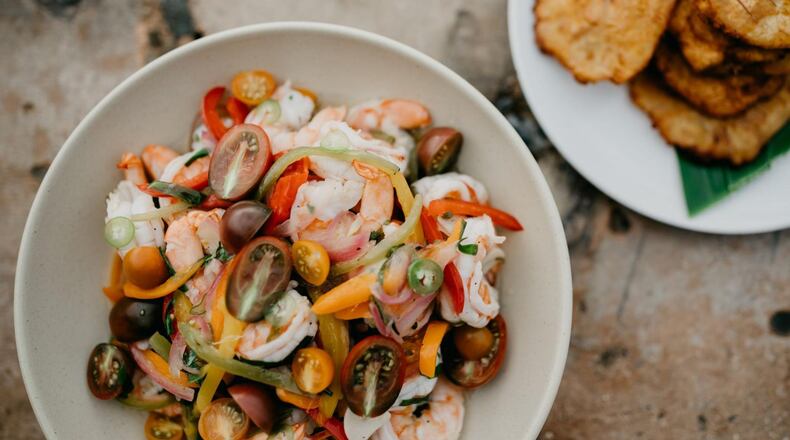Chef Digby Stridiron extended the invitation for me to visit him at home in St. Croix years ago. We were a few months into our burgeoning friendship after a fortuitous meeting at a chefs’ conference in Italy. At the time, I was captivated by the stories he shared with me of the place that helped shape him as a man and a chef.
“Come to the island,” Digby teased, smiling at me as if my acceptance of his generous invitation to join him in the U.S. Virgin Islands was a foregone conclusion. “The food, the lush scenery, the gentle island breezes. … You’ll fall in love just like I have,” he said.
Eventually, I got around to saying yes. And last month, I excitedly packed my bags and prepared to meet him.
The morning after I arrived, I awoke to the sound of piercing ocean waves crashing outside my seaside hotel. The scenery transformed me almost instantly to another time and another place, one that reminded me of the beach home of my childhood in Kerala, India. The air was dense, just like the part of India I was raised in, with the heady perfume of tropical fruit: mango, soursop, guava. The landscape was lush and green everywhere.
Born and raised in St. Croix, Digby has taken his culinary passions across continents while garnering critical acclaim for his innovative culinary interpretation of Crucian cuisine. His cooking is a delicate, but well-executed dance that weaves together influences of the native Taino Indians, the West African diaspora and the spices of India, illustrating how each culture has left an indelible imprint on Caribbean food.
Having cooked with and for culinary greats such as Massimo Bottura, Paul Bocuse and Daniel Boulud, it’s obvious that Digby’s techniques and food sensibilities are informed by exposure to his classically trained mentors and perhaps most importantly by an abiding appreciation for traditional West Indian flavors and culture.
What I discovered during my visit were a surprising number of similarities between Southern food and the cuisine of St. Croix. What I knew in my vocabulary as grits had been derived and known here as fufu or funji. Made with cornmeal and okra, it’s an ancestral cousin to okra stew and gumbo’s iconic place in American cooking due to the trans-Atlantic slave trade. Crucian curry chicken was so richly different than the Indian variety I grew up with, and yet the familiarity was striking and ultimately comforting.
I accompanied Digby as he sourced and foraged for produce for his restaurants Braata and Ama, meeting young farmers that were growing beautiful ingredients and finding ways to create sustainable agriculture. Digby is spearheading a movement of sorts to encourage farmers on the island to grow their own crops to decrease St. Croix’s reliance on importing products from the mainland. He’s not simply content with the farm-to-table movement. What really gets him excited is sustainability and wild-to-table. “We’re not just going to the farmers and saying, ‘Hey, can we have the best produce that you have?’ Let’s go out there and find it first. Let’s put our hands in the dirt, or go swim and catch the conch. Let’s find the best produce that the island has to offer.”
Something struck me while I watched Digby work: We aren’t used to thinking of chefs as heroes. After all, they don’t necessarily resemble Marvel Comics characters or wear capes. But to me, everyday heroes are all around us, doing heroic work that often goes unnoticed and shapes the world in ways that we may take for granted, affecting lives in small, subtle ways.
Most heroes on their journey find a moment of clarity that defines and shapes who they end up wanting to become. For Digby, that moment came in 2017 when Hurricane Maria’s wide-reaching devastation hit the U.S. Virgin Islands. Beyond the loss of life and property, the long-term effects of the calamity took its toll on tourism, which is one of the region’s largest sources of revenue and jobs.
While many were fleeing the island, Digby decided it was time for him to return home. He went back and opened his own restaurant, Braata. It was the culmination of his dream to showcase the beauty of his traditions in the best way he knew how. “Coming back is a full circle for me,” he said. “I was away focusing on me, but now I feel like I want to make a contribution to my community.” Connecting to the community meant local job creation, advocacy work for providing nourishing meals for impoverished schoolchildren and working to make the island more self-sustainable.
“One of the things I learned from the storm was the reality of grocery stores running out of food and having no way to get food to us from the mainland,” Digby commented. “Creating food security through sustainable agriculture and raising heritage animals is now a big passion for me.”
Some heroes wear capes and leap from tall buildings; other heroes cook from their heart and soul and nourish much more than an empty belly.
Asha Gomez is an Atlanta chef and the author of the cookbook “My Two Souths” and the forthcoming “Color Full: A World of Bright Flavors From My Kitchen,” to be published in spring 2020.
Recipes from Digby Stridiron, executive chef of Braata and Ama in St. Croix, adapted by Asha Gomez.
Crucian Curry Chicken
Curries have reached across oceans and continents and found their way into kitchens and cuisines around the world, including the Caribbean. This dish is best eaten with steamed white rice or roti. The recipe calls for palm oil. Naturally red in color, palm oil has the same semisolid texture as coconut oil when at room temperature and is a highly saturated oil. If you can’t find palm oil, use coconut oil.
Shrimp Escabeche Salad
Over the years, I’ve traveled extensively through the Caribbean and U.S. Virgin Islands. Whether in Jamaica, St. Lucia, St. Croix, St. Thomas, Puerto Rico or Antigua, no other dish captures the beauty of Caribbean cuisine more than escabeche.
Red Grout with Rum Raisin & Nuts
Red group is a type of tapioca pudding that holds tropical flavors. Find quick-cooking tapioca as well as almond essence at most well-stocked grocery stores.
each serving, followed by the strawberries and the rum raisin-nut mixture. Garnish with the mint leaves. Serves 4.
Per serving: 651 calories (percent of calories from fat, 38), 10 grams protein, 91 grams carbohydrates, 6 grams fiber, 28 grams fat (9 grams saturated), no cholesterol, 431 milligrams sodium.
RELATED:
Read more stories like this by liking Atlanta Restaurant Scene on Facebook, following @ATLDiningNews on Twitter and @ajcdining on Instagram.c
About the Author
Keep Reading
The Latest
Featured






